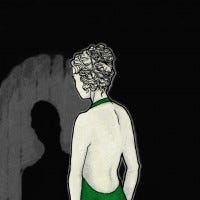Analysis: Vampiric Intentions - Story In Love and Death: Bitten
In this critical analysis, interactive fiction author Emily Short comments on PlayFirst's vampire-themed hidden object game Love and Death: Bitten, the latest in her ongoing series of looks at storytelling and narrative in games of all flavors.

[In this critical analysis, interactive fiction author Emily Short comments on PlayFirst's vampire-themed hidden object game Love and Death: Bitten, the latest in her ongoing series of looks at storytelling and narrative in games of all flavors.] According to some branches of non-Stoker lore, vampires have an obsession with tidiness: they can't pass by a knot without untying it, or a spill of dried peas without picking them up. A ball of twine and a bag of rice are almost as good against a vamp as a stake and holy water. Some such rationale might half explain Love and Death: Bitten, a vampire love story/hidden object game. In between plot events (and sometimes even when gripped by the urgency of the hunt) the vampire protagonist will stop to collect, say, six match sticks, five plates, and a pair of stockings from a messy room. This doesn't explain why his human love interest does the same. I am not a great fan of hidden object gameplay. I played Love and Death: Bitten for two reasons: it was getting strong reviews as a casual game with a lot of story content, and it also contains a number of other types of puzzle. The reviews don't lie: if we set aside the essential implausibility that the protagonists stop at the most inopportune times to search for trinkets, this is a pretty decent story/gameplay mesh for a hidden object game. During the opening scenes, we're invited to visit the same places as both the vampire Damon and the human Victoria, and the things they look for and notice remind us of their differences. Damon is more agile, but he has his vulnerabilities, too: there are things he can't touch or step on, and he has a need for blood now and then to replenish his strength and let him lift heavy things. Victoria can't climb to the same heights, but crosses don't bother her. The meaningful shift in perspective makes it somewhat more tolerable to search the same settings twice and do the same puzzles over again in just-slightly-different variants. After the first act, the hidden object experience is used to unveil Damon's past and the characters' different attitudes towards that past, rather than to set up their overall abilities. Much of the action is set in the castle where he lives: the hidden object screens are full of memories when he manipulates them, and discovery when Victoria does. The list of objects to find in a given scene gives some hint about what the viewpoint character might be thinking, even when he or she offers no explicit comment. Victoria, for instance, investigating Damon's study, finds an assortment of objects that point at his talents and musical abilities. Damon, on the other hand, notices the tokens given to him by previous lovers, and cast-off bottles of wine -- hints at a dissolute lifestyle. The game does not go into this in any explicit detail, but perhaps we can judge from this that Victoria sees Damon more favorably than he sees himself. In any case, it's a relatively deft and thoughtful use of this play style. Finally, in one scene, the player is required to combine the hidden objects into a tableau that tells the full story of Damon's background. It's contrived, but it does work; it gives the backstory of how Damon became what he is, and connects several previously unexplained pieces of evidence. There are some missteps. The authors don't help themselves by drawing attention to the implausibility of doors that can only be unlocked with the right collection of four tiny related objects (or seven, or twenty, depending on how far you are through the plot and how determined are the designers to string things out). The heroine thinks aloud about this several times, which is a mistake. All the same, the multiple viewpoint tricks, and the exposition by way of hidden object screen, do surprisingly well to bring together story and game.  At the end of the day, though, these merits are relative: the story in Love and Death: Bitten is decent for the kind of game it is, which is to say, if you're expecting almost nothing. Looked at with any seriousness, it falls apart. It is held together by convention, not by compelling narrative logic. Why should Damon seek out Victoria as a victim, then refuse to kill her? He gives some weak explanation of having to leave because dawn was approaching, but I'm sure he could have spared the time to bite or abduct her first, if he'd really wanted to. Why does Victoria fall for the man who has been terrorizing her town, based chiefly on a couple of extremely weak exchanges of witty banter? Why does Damon strike a cheesy pose in his own garden with his poet shirt open down the front? Do these characters have anything in common but the expectations of the genre in which they find themselves? No. They're not in love, not really. They don't have motives. They're contractually obligated to get themselves into such situations as cliche demands, that's all. There are other games that take their writing more seriously or are more inventive, but a very great number of them share the core problem with Love and Death: Bitten. It feels constructed. It is an artificial rose hot-glued together from the scavenged petals of other artificial roses. There is not a moment of human truth from one end to the other. That's not because it's a fantasy about vampires. "Buffy the Vampire Slayer" was a fantasy about vampires, and that had many moments of raw surprising honesty. The premise doesn't have to be realistic for the characters to be truthful. "Buffy" puts its most affecting observations about the nature of death into the mouth of a thousand-year-old retired vengeance demon. Genre conventions supply premises, situations, and types of conflict. Genre signals to players what sorts of interaction they can expect to have. Genre is useful. The problem arises when a game or story has nothing to offer beyond what the genre has already supplied. What "Buffy" has, what Love and Death: Bitten and many other games lack, is observation. Within an imagined universe where we accept that vampires are real, it still places plausible people at the center. The characters have motivations we recognize and actions that feel right instead of obvious. For that to happen, the writers have to be willing to look not just at other works in the same genre, but at the real world. (Disclosure: I played a copy of this work that I purchased at full price. I have had no commercial affiliations with the publisher at the time of writing.) [Emily Short is an interactive fiction author and part of the team behind Inform 7, a language for IF creation. She also maintains a blog on interactive fiction and related topics. She also contracts for story and design work with game developers from time to time, and will disclose conflicts with story subjects if any exist. She can be reached at emshort AT mindspring DOT com.]
At the end of the day, though, these merits are relative: the story in Love and Death: Bitten is decent for the kind of game it is, which is to say, if you're expecting almost nothing. Looked at with any seriousness, it falls apart. It is held together by convention, not by compelling narrative logic. Why should Damon seek out Victoria as a victim, then refuse to kill her? He gives some weak explanation of having to leave because dawn was approaching, but I'm sure he could have spared the time to bite or abduct her first, if he'd really wanted to. Why does Victoria fall for the man who has been terrorizing her town, based chiefly on a couple of extremely weak exchanges of witty banter? Why does Damon strike a cheesy pose in his own garden with his poet shirt open down the front? Do these characters have anything in common but the expectations of the genre in which they find themselves? No. They're not in love, not really. They don't have motives. They're contractually obligated to get themselves into such situations as cliche demands, that's all. There are other games that take their writing more seriously or are more inventive, but a very great number of them share the core problem with Love and Death: Bitten. It feels constructed. It is an artificial rose hot-glued together from the scavenged petals of other artificial roses. There is not a moment of human truth from one end to the other. That's not because it's a fantasy about vampires. "Buffy the Vampire Slayer" was a fantasy about vampires, and that had many moments of raw surprising honesty. The premise doesn't have to be realistic for the characters to be truthful. "Buffy" puts its most affecting observations about the nature of death into the mouth of a thousand-year-old retired vengeance demon. Genre conventions supply premises, situations, and types of conflict. Genre signals to players what sorts of interaction they can expect to have. Genre is useful. The problem arises when a game or story has nothing to offer beyond what the genre has already supplied. What "Buffy" has, what Love and Death: Bitten and many other games lack, is observation. Within an imagined universe where we accept that vampires are real, it still places plausible people at the center. The characters have motivations we recognize and actions that feel right instead of obvious. For that to happen, the writers have to be willing to look not just at other works in the same genre, but at the real world. (Disclosure: I played a copy of this work that I purchased at full price. I have had no commercial affiliations with the publisher at the time of writing.) [Emily Short is an interactive fiction author and part of the team behind Inform 7, a language for IF creation. She also maintains a blog on interactive fiction and related topics. She also contracts for story and design work with game developers from time to time, and will disclose conflicts with story subjects if any exist. She can be reached at emshort AT mindspring DOT com.]
About the Author(s)
You May Also Like







.jpeg?width=700&auto=webp&quality=80&disable=upscale)








